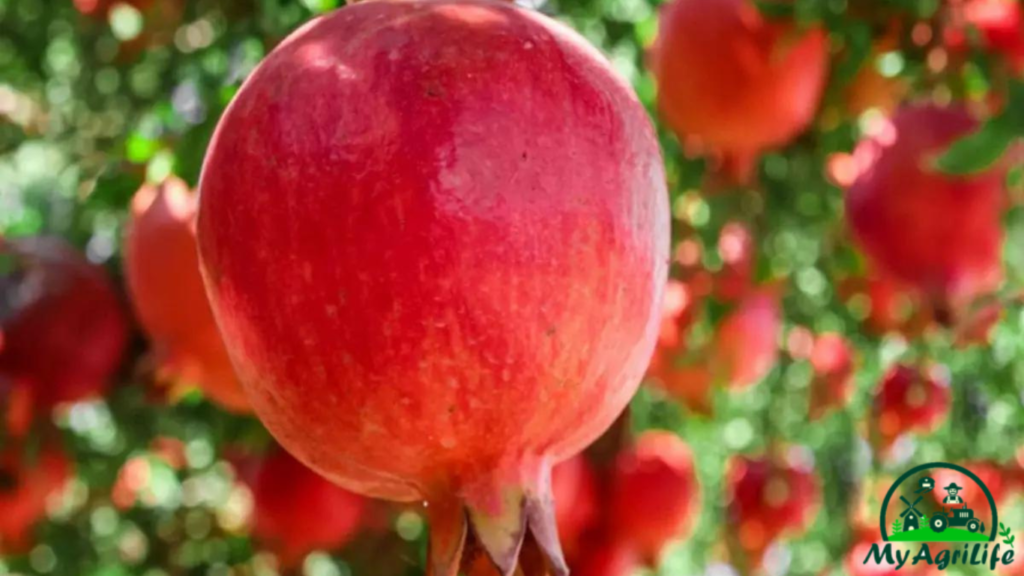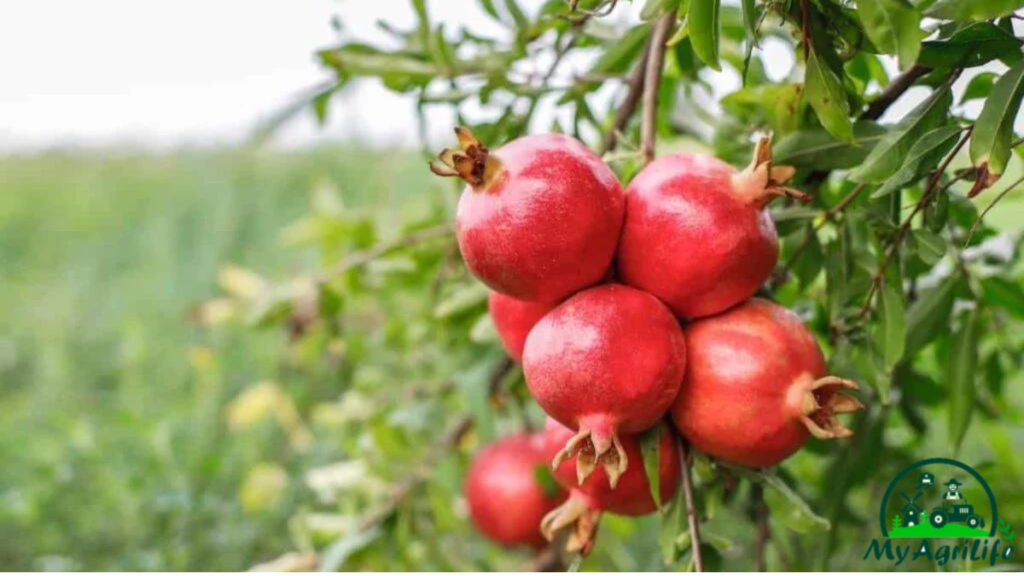Pomegranate, also known as Anar in Hindi, is a fruit that is native to Iran and is now grown in many parts of the world, including India. It is a round, reddish fruit with a tough outer skin, and inside it contains juicy, edible seeds called arils.

Pomegranates are packed with nutrients and are considered to be a superfood. They are a good source of vitamin C, vitamin K, and potassium. They also contain antioxidants, which help to protect the body against damage from free radicals.
Pomegranate juice is also becoming increasingly popular due to its health benefits. Studies have shown that drinking pomegranate juice may help to reduce the risk of heart disease, lower blood pressure, and improve overall heart health. It may also have anti-inflammatory properties and could be helpful in managing certain types of arthritis.
In addition to their health benefits, pomegranates are also used in cooking and can be eaten raw or used in a variety of recipes, such as salads, smoothies, and desserts. The seeds can also be used to make a juice or syrup that is popular in many cultures.
Seed Specification Pomegranate
The seeds of the pomegranate, also known as arils, are a key part of the fruit and have a unique taste and texture. Here are some specifications for pomegranate seeds:
1.Appearance: Pomegranate seeds are small, red, and juicy. They are typically about the size of a kernel of corn, although they can vary slightly in size.
2.Taste: Pomegranate seeds are tart and sweet, with a slightly crunchy texture. They have a unique flavor that is difficult to describe, but is often compared to a combination of cranberries and grapes.
3.Nutrition: Pomegranate seeds are high in fiber, vitamin C, and antioxidants. They are also a good source of vitamin K and potassium.
4.Preparation: To extract the seeds, cut the pomegranate in half and gently remove the arils with a spoon or your fingers. Be careful not to break the seeds, as they can stain clothing and surfaces.
5.Storage: Pomegranate seeds can be stored in the refrigerator for up to 5 days. They can also be frozen for longer storage, but may lose some of their texture and flavor when thawed.
6.Culinary uses: Pomegranate seeds are often used as a garnish in salads, cocktails, and other dishes. They can also be used to make a juice or syrup that is popular in many cultures.
Land Preparation & Soil Health Pomegranate
Pomegranate is a hardy fruit tree that can grow in a range of soils, but it prefers well-drained soils that are rich in organic matter. Here are some tips for land preparation and maintaining soil health for pomegranate cultivation:
1.Site selection: Choose a site that receives full sun for most of the day and has good air circulation. Avoid areas with poor drainage or low-lying areas that are prone to flooding.
2.Land preparation: Clear the site of any weeds, rocks, or other debris. Till the soil to a depth of 30-40 cm and incorporate organic matter such as compost or manure to improve soil fertility and structure.
3.Soil testing: Test the soil to determine its pH and nutrient content. Pomegranates prefer a slightly acidic soil with a pH between 5.5 and 7.0. If the soil is too acidic, lime can be added to raise the pH.
4.Fertilization: Pomegranate trees require regular fertilization to promote healthy growth and fruit production. Apply a balanced fertilizer with a ratio of 10-10-10 or 14-14-14 in early spring and late summer. Organic fertilizers such as compost, bone meal, or fish meal can also be used.
5.Mulching: Apply a layer of organic mulch such as straw or leaves around the base of the tree to help retain moisture and suppress weeds.
6.Irrigation: Pomegranate trees require regular watering, especially during the first few years of growth. Irrigate the trees deeply and infrequently to encourage deep root growth.
7.Crop rotation: To maintain soil health and prevent soil-borne diseases, rotate the pomegranate crop with other crops such as legumes or cereals.
By following these tips, you can create optimal soil conditions for pomegranate cultivation and promote healthy growth and fruit production.
Crop Spray & Fertilizer Specification Pomegranate
Pomegranate trees require proper nutrition and pest management to produce high-quality fruit. Here are some recommendations for crop spray and fertilizer specification for pomegranate cultivation:

Crop Spray
Pomegranate trees are susceptible to fungal diseases such as powdery mildew and bacterial blight. To prevent these diseases, apply a fungicide spray during the growing season, especially during periods of high humidity or rainfall.
Insect pests such as fruit flies, aphids, and mealybugs can also damage pomegranate fruit. Insecticides can be applied as needed to control these pests. However, it is important to use insecticides judiciously to minimize the risk of developing resistance.
Consult with a local agricultural extension service or a licensed agronomist to determine the appropriate crop spray regimen for your specific location and growing conditions.
Fertilizer Specification
Pomegranate trees require regular fertilization to maintain healthy growth and fruit production. A balanced fertilizer with a ratio of 10-10-10 or 14-14-14 can be applied in early spring and late summer.
In addition to a balanced fertilizer, pomegranate trees benefit from organic fertilizers such as compost, bone meal, or fish meal. These organic fertilizers can be applied in the fall or winter to improve soil fertility and structure.
Pomegranate trees have a high demand for potassium, which is essential for fruit development. Potassium can be applied in the form of potassium sulfate or potassium nitrate.
Avoid excessive use of nitrogen fertilizer, which can promote vegetative growth at the expense of fruit production.
Test the soil regularly to determine its nutrient content and adjust the fertilizer application accordingly.
By following these recommendations for crop spray and fertilizer specification, you can promote healthy growth and fruit production in your pomegranate orchard.
Weeding & Irrigation Pomegranate
Weeding and irrigation are important aspects of pomegranate cultivation to ensure healthy growth and fruit production. Here are some recommendations for weeding and irrigation for pomegranate trees:

Weeding
Weeds compete with pomegranate trees for water and nutrients, which can reduce growth and fruit production. Weeds also harbor pests and diseases that can damage the trees.
Control weeds by hand weeding or using herbicides. However, it is important to use herbicides judiciously and follow the label instructions to avoid damaging the trees or the environment.
Apply a layer of organic mulch such as straw or leaves around the base of the tree to help suppress weeds and retain moisture.
Irrigation
Pomegranate trees require regular watering, especially during the first few years of growth. Irrigate the trees deeply and infrequently to encourage deep root growth.
In areas with high evaporation rates, drip irrigation is recommended as it delivers water directly to the root zone and reduces water loss due to evaporation.
Water stress can affect fruit size and quality, so it is important to monitor soil moisture and water the trees as needed.
During periods of heavy rainfall, adjust the irrigation schedule to avoid overwatering the trees, which can lead to waterlogging and root rot.
By following these recommendations for weeding and irrigation, you can promote healthy growth and fruit production in your pomegranate orchard.
Harvesting & Storage Pomegranate
Harvesting and storage are important steps in ensuring high-quality pomegranate fruit. Here are some recommendations for harvesting and storage of pomegranates:
Harvesting
Pomegranates are typically harvested when the fruit is fully ripe and the skin is a deep red color. The fruit should be firm and heavy for its size.
Use pruning shears or a sharp knife to cut the fruit from the tree. Be careful not to damage the fruit or the tree.
Handle the fruit gently to avoid bruising, which can lead to decay.
Storage
Store ripe pomegranates in a cool, dry place with good ventilation. Do not stack the fruit too high to avoid crushing the fruit at the bottom of the stack.
Pomegranates can be stored for up to two months at 7-10°C and a relative humidity of 85-90%. However, the storage time and temperature may vary depending on the cultivar and storage conditions.
Avoid storing pomegranates with other fruits or vegetables that produce ethylene gas, which can accelerate ripening and decay of the fruit.
Before storage, inspect the fruit for any signs of damage or decay. Discard any fruit that is damaged or shows signs of decay.
By following these recommendations for harvesting and storage, you can ensure that your pomegranate fruit is of high quality and has a longer shelf life.
Conclusion
In conclusion, pomegranate farming can be a rewarding endeavor. Pomegranate trees are hardy and can thrive in various soil types, as long as they have good drainage. Proper land preparation, including clearing weeds and incorporating organic matter, is essential for healthy tree growth.
Pomegranate trees require regular fertilization, with a focus on balanced fertilizers and additional potassium. Crop spraying may be necessary to manage pests and diseases, such as fungal infections and insect infestations. However, it’s important to use pesticides judiciously and consider organic and sustainable alternatives.
Weeding and irrigation are crucial for maintaining optimal growth conditions. Controlling weeds helps prevent competition for resources, while appropriate irrigation practices, such as deep watering and drip irrigation, ensure the trees receive sufficient water without risking waterlogging.
Harvesting pomegranates at the right time, when they are fully ripe and exhibit the desired color and firmness, is crucial for quality. Proper storage in a cool, dry place with good ventilation can extend the fruit’s shelf life.
Overall, successful pomegranate farming requires attention to detail, proper nutrition, pest management, and good agricultural practices. By following these guidelines, farmers can cultivate healthy pomegranate trees and enjoy the benefits of this versatile and nutritious fruit.









